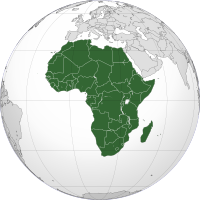
Photo from wikipedia
The main states of the Angola Low (AL) are identified using clustering analysis applied to daily anomalous patterns of 700-hPa wind vorticity over Angola and adjacent countries from November to… Click to show full abstract
The main states of the Angola Low (AL) are identified using clustering analysis applied to daily anomalous patterns of 700-hPa wind vorticity over Angola and adjacent countries from November to March for the 1980/81–2014/15 period. At the daily timescale, we examine the extent to which the main states of the AL modulate daily rainfall over southern Africa. At the interannual timescale, we assess both the relationship between the occurrence of these AL states and El Niño southern oscillation (ENSO) and the role of the AL in explaining ENSO’s failure in driving southern African rainfall at times. Three reanalyses are considered to account for uncertainties induced by the scarcity of data available for assimilation over southern Africa. Three preferential states of the Angola Low are identified: AL state close to its seasonal climatology with slight zonal displacements, anomalously weak AL state and anomalously strong AL state with meridional displacements. These different states all significantly modulate daily southern African rainfall. Near-climatological AL state promotes wet rainfall anomalies over eastern subtropical southern Africa and dry rainfall anomalies over its western part. A slight westward shift in the near-climatological position of the AL leads to reversed zonal gradient in rainfall. The remaining regimes significantly modulate the meridional gradient in southern African rainfall. Anomalously weak and anomalously northward AL states promote wet rainfall anomalies over tropical southern Africa and dry rainfall anomalies over subtropical southern Africa. The reverse prevails for anomalously southward AL. At the interannual timescale, ENSO significantly modulates the seasonal occurrence of most AL states in the three reanalyses. Anomalously weak and southward AL states are more strongly correlated with regional rainfall than ENSO in all reanalyses, suggesting that accounting for AL variability may improve seasonal forecasts. Case study analysis of the major 1982/83 and 1997/98 El Niño events suggests that the weak rainfall anomalies and strong seasonal AL in 1997/98 may result from counteracting effects between ENSO and Indian Ocean coupled modes of variability.
Journal Title: Climate Dynamics
Year Published: 2018
Link to full text (if available)
Share on Social Media: Sign Up to like & get
recommendations!